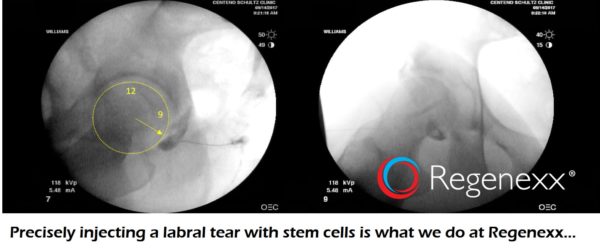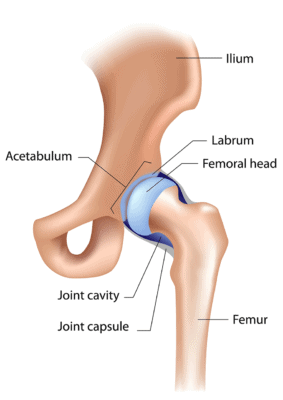Hip Labrum Tear Stem Cell Procedure: It’s What We Do Every Day

©Regenexx
With all of the magic stem cell clinics popping up willing to hook you up to an IV or give you a blind injection of dead amniotic or cord “stem cells,” it’s sometimes hard for patients to understand just how different what we do every day at Regenexx is when compared to these clinics. Given that we teach physicians from all over the world how to perform precise orthopedic injection procedures, we often get films like the one above sent by our former fellows. This one was sent by now attending physician, Chris Williams, MD. This hip labrum stem cell procedure exemplifies the best of what we do at Regenexx and the intense training and skill that it requires to master these procedures. Let me explain.
Hip Labrum Tears

Alila Medical Media/Shutterstock
Think of the hip labrum as a gasket that goes around the rim of the socket where the hip bone attaches. Its job is to help hip stability, and we’ve seen an entire surgical industry grow up around tears in this structure. While we have little hard evidence that these surgeries help, they now represent a multibillion-dollar industry. However, what if you didn’t need the invasive surgery? What if platelets or stem cells that could help ramp up healing could be delivered precisely to the spot via a guided injection? What if there was such a thing as a hip labrum stem cell injection? There is…
Precise Injections or Interventional Orthopedics
It’s sometime hard for patients to understand just how complex and training intensive it is to place high-dose platelets or stem cells into a specific spot in the body. Basically, most of what your family doctor, a physician extender at a chiropractic office, or an orthopedic surgeon knows how to do are simple injections either blind or with ultrasound. Those are quite different from the interventional-orthopedic procedures we’re talking about here. To lean more, watch the video below:
A Hip Labrum Tear Stem Cell Procedure with Ultrasound and Fluoroscopy
Ninety-nine percent of all the injections that you could get in your hip tomorrow aren’t specifically targeting tears in your hip labrum. In fact, 99% of the physicians wouldn’t have any idea how this is done. Why? Because precise, hip labrum stem cell injection procedures aren’t taught in medical school or any residency program as of 2017. In fact, the only structured coursework I know of right now is either through the Interventional Orthopedics Foundation (IOF) or one of a handful of interventional-orthopedic fellowship programs, including ours. With that in mind, let’s take a look at Dr. Williams’s injection above. To learn more about our fellowship programs, see the video below:
To help everyone understand where a hip labrum tear is located, radiologists have created a few naming systems. The simplest one uses a clock face, which I have drawn on top of the hip fluoroscopy image above (on the left in yellow). In this case, the patient’s labral tear was at the eight o’clock position. While it would seem that it would be a simple matter to inject this spot without guidance, your chances of hitting it that way would be about 1 in 100 or less. Even with ultrasound imaging, it’s not easy to hit. The problem with ultrasound is that while it’s good at showing you a cross section of the area, the labrum in this spot is buried some 3–10 or more inches deep (depending on the patient). Hence, using real-time X-ray imaging plus ultrasound is the easiest way to ensure that the stem cells find the exact spot of the tear. That’s exactly what Dr. Williams has done here. The dark stuff at where the hours hand points to eight is the contrast that was followed by the stem cells. The image on the right was to double confirm the placement.
How many physicians are there right now who could use ultrasound and fluoroscopy to get to this tear and have done it enough times to say they’re competent and know anything about platelets or stem cells? Fewer than 50–100, and most of the those are either current or future Regenexx providers. So when Dr. Williams sent me the above hip labrum tear stem cell injection picture, it’s actually a bigger deal than it appears.
The upshot? Do you need labral tear surgery? Likely not. If the goal is to heal the tear, for most patients, that can be accomplished by ramping up local healing through an injection of high-dose platelets or stem cells. The problem is, of course, getting those things to the right spot without invasive surgery, which is where the real magic happens.

If you have questions or comments about this blog post, please email us at [email protected]
NOTE: This blog post provides general information to help the reader better understand regenerative medicine, musculoskeletal health, and related subjects. All content provided in this blog, website, or any linked materials, including text, graphics, images, patient profiles, outcomes, and information, are not intended and should not be considered or used as a substitute for medical advice, diagnosis, or treatment. Please always consult with a professional and certified healthcare provider to discuss if a treatment is right for you.
